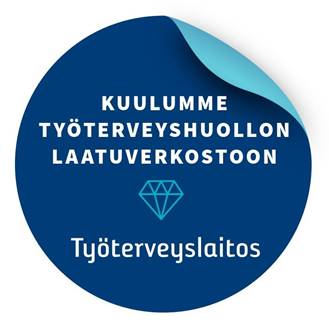

The ABCs of occupational health
Glossary of occupational health services
In the ABCs of occupational health, you will find a brief explanation of the most common terms and concepts related to occupational health.
The ABCs of Occupational Health
An agreement concluded between an employer and an occupational health care service provider in which the general arrangements of occupational health care, the contents and extent of services and the duration of the agreement are laid out.
General arrangements refers, for example, to the location and business hours of clinics, geographic layout of the services and subcontractors if the company is active in several locations.
The contents and extent of services refers to the description of statutory services included in the occupational health care agreement that are preventive (Category 1) and support work ability as well as any additional non-mandatory health care services agreed upon (Category 2).
The employer is reimbursed for the necessary and reasonable costs of providing occupational health care. According to the Occupational Health Care Act, the following are eligible for compensation:
- The expenses of statutory and preventive occupational health care (Category 1).
- The costs of general practitioner’s health care services and other health care services (Category 2).
Every year, Kela defines the theoretical maximum amount of costs per employee for both categories. To be eligible for reimbursement, the employer must have a written occupational health agreement, a workplace survey and an action plan.
The occupational health care provider will pre-fill the information on the employer's occupational health care costs after the end of the financial year, once all invoices relating to the application of reimbursement have been paid. The service provider sends the details of the application to Kela service for the company to fill in.
Read more about submitting the basic informationExternal link.
Read more about Kela reimbursements on the Kela websiteExternal link (Kela web page in Finnish)
Costs incurred by preventive activities and activities that maintain employees’ work ability through workplace surveys, workplace visits, health examinations, work ability assessment and support, guidance, instructional activities and maintaining the capacity to administer first aid belong to Kela’s reimbursement category 1.
The amount of reimbursement is 60% of the verified necessary and reasonable expenses if the basic criteria of reimbursement are met and the service has been provided in accordance with generally accepted occupational health care practices.
The costs of any non-mandatory general practitioner level health care services arranged by the employer as well as the costs of any occupational health care services arranged in addition to the statutory services belong to the Kela reimbursement category 2. Other healthcare costs include, for example, influenza vaccinations for medical risk groups and the monitoring needed to prescribe treatment before an illness is diagnosed.
The amount of reimbursement is 50% of the costs, according to the ceiling. Medical costs can be taken into account if there is a maximum amount left after the preventive costs, up to a maximum of 40% of the common maximum amount.
Read more about Kela's reimbursement policiesExternal link.
All occupational health care activities are based on the workplace survey. The purpose of the workplace survey is to study the conditions of the job and its conditions and their impact on health.
The workplace survey includes an analysis of the workplace’s exposure agents, the job’s physical and psychosocial stress factors, resources, work arrangements and risks of accidents. Studying the workplace’s preparedness to perform first aid is also part of the workplace survey. Workplace surveys are always performed by visiting the workplace in person. The survey is used to plan and perform the measures required to promote health and work ability.
Employers must implement a written occupational health care action plan created in cooperation between the employer and the occupational health care service provider. All action plans are based on a workplace survey. The action plan includes the general goals of occupational health care and the needs based on the workplace conditions and the caused measures.
The action plan may be valid for one year at a time, or, as in most cases, for 3–5 years, when it is revised annually. A valid action plan is required in order for the occupational health care activities to be eligible for Kela reimbursement.
Exposure agents are external factors that people are exposed to and can cause adverse effects. Biological exposure agents include, for example, bacteria, mould, viruses and invertebrate animals. Physical exposure agents include, for example, noise, vibration, illumination, temperature and radiation. Chemical exposure agents include, for example, mineral dust, metals and compounds, organic dust and compounds, gases and reduced sulphur compounds. Carcinogenic exposure agents include, for example, asbestos, chromium compounds, nickel compounds, benzene and chloroform.
The basic method of monitoring employees’ health status is performing health checks. The purpose of a health checks is to study, assess and monitor the employee’s health and functional capability.
Two different types of health checks are arranged. Statutory health checks performed at the beginning of an employment relationship and at regular intervals are based on exposure agents that may cause serious adverse health effects. Such exposure agents include, for example, noise and certain chemicals. Voluntary health checks are based on an agreement between the employer and the occupational health care service provider regarding health checks for certain age groups or job titles, for instance. Learn more about occupational health checks
Work accidents are sudden accidents caused by external factors in a work environment that cause an employee to become injured. Work accidents may occur at the workplace, while commuting to or from work or when travelling for work on the employer’s commission. Learn more about work accidents. (web page in Finnish)
The purpose of occupational health negotiations (tripartite negotiation, work ability meeting, network negotiation) is to find solutions to problems related to work, the work environment, or the work community that have an effect on the employee’s work ability and health. The negotiations are not about processing an employee’s personal health data. The discussions focus on coping at work and any related matters.
An occupational health negotiation may be called by an employee, a supervisor or the occupational health care service provider. The employee has the right to decide which parties are present at the negotiation. In most cases, the negotiations include the employee, their closest supervisor and a representative or several representatives of the occupational health care service provider. In addition, the company’s occupational safety representative may be invited to the negotiations. Learn more about occupational health negotiations (web page in Finnish)
Mehiläinen’s work coaches are experts trained in social services. The special skills of work coaches include professional rehabilitation and continuing careers. Work coaching services are ideal in situations where the employee’s ability to continue working in their current position or returning to work is at risk due to health-related reasons. Work coaching can also be useful when an employee needs support with the preparation of a career plan in the event of dismissal. Learn more about work coaching.
Occupational health care cooperation is performed between different parties in a functional environment under a mutual agreement. A functional cooperation environment ensures that employees are provided high-quality treatment and monitoring services. According to the Occupational Health Care Act, the employer is responsible for arranging activities that maintain work ability and that the employer must apply the expertise of an occupational health care service provider in arranging the activities. The employer, the cooperation organisations of the employer and the occupational health care service provider must always be kept up to date about the work ability situation of the workplace. Cooperation between the employer and the occupational health care service provider has been proven to support work ability and improve coping at work.
Sick leave refers to the period during which an employee is unable to work due to illness. Kela provides sickness allowance for the duration of the illness if the person is incapacitated for their own work. Read more about sick leave.
If a person’s incapacity for work lasts for less than a year, they are eligible for a sickness allowance paid by Kela. The sickness allowance system involves a waiting period of approximately 2 weeks (date of falling ill and the following 9 business days). Learn more about sickness allowance. (web page in Finnish)
The partial sickness allowance issued by Kela helps people incapable of performing their job to return to work or retaining their work ability. The partial sickness allowance is payable for a maximum of 120 business days. Learn more about partial sickness allowance. (web page in Finnish)
Several employers allow employees to be absent from work due to an illness for approximately 1–5 days without a sick leave certificate issued by a doctor or a nurse by simply notifying the employer. Learn more about sick leave without a certificate. (web page in Finnish)
Sick leave certificates are certificates issued by doctors or nurses that indicate a temporary incapacity for work due to an illness. Employees can prove that they are incapable of performing their job by presenting a sick leave certificate to their employer. Learn more about sick leave certificates. (web page in Finnish)
According to the Employment Contracts Act, employees are entitled to sick leave pay for the duration of the sickness allowance waiting period. Learn more about sick leave pay. (web page in Finnish)
If an employee falls ill during a holiday, the agreed annual leave is not postponed automatically, but the employee must request a postponement from the employer. In such cases, a sick leave certificate issued by a doctor must be presented to the employer. If the employee is incapable of performing their job when an annual leave is due to begin, the leave must be postponed upon the employee’s request. Learn more about falling ill during a holiday. (web page in Finnish)
If you fall ill during a holiday, the waiting period before qualifying for sick leave is referred to as a sick leave waiting period. The sick leave waiting period only applies to employees who are entitled to more than four weeks of annual leave. Learn more about the sick leave waiting period. (web page in Finnish)
Employers are obliged to provide occupational health care on their own expense, therefore, employees don't need to pay for their visit fees. Kela will reimburse employers 60% of accepted and reasonable occupational health care costs. Every year, Kela defines the theoretical maximum amount of costs per employee for both categories. Kela's reimbursement is payed from work income insurance which is accumulated from earned income. Work income insurance is funded mainly by employers (73%) and employees (27%).

